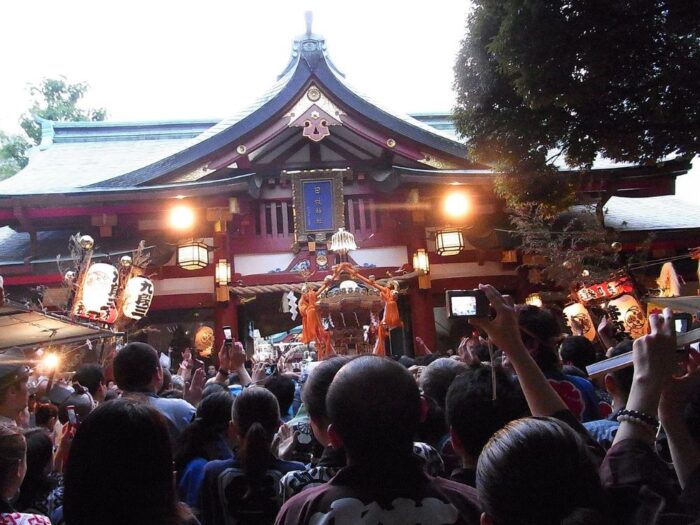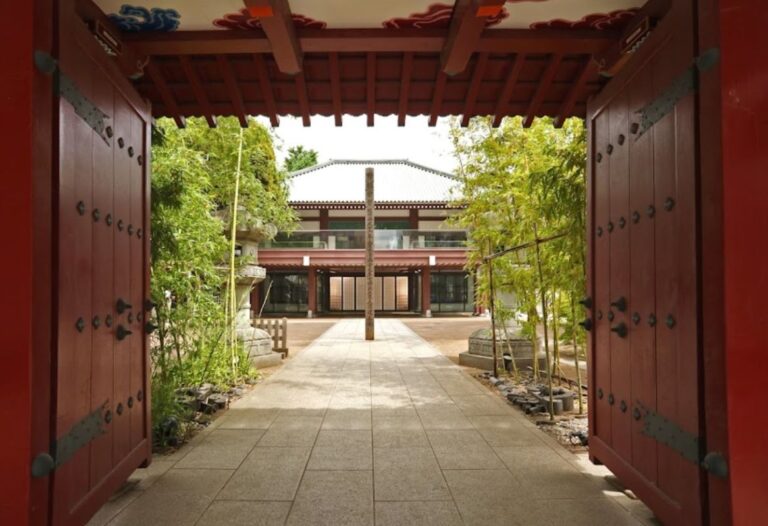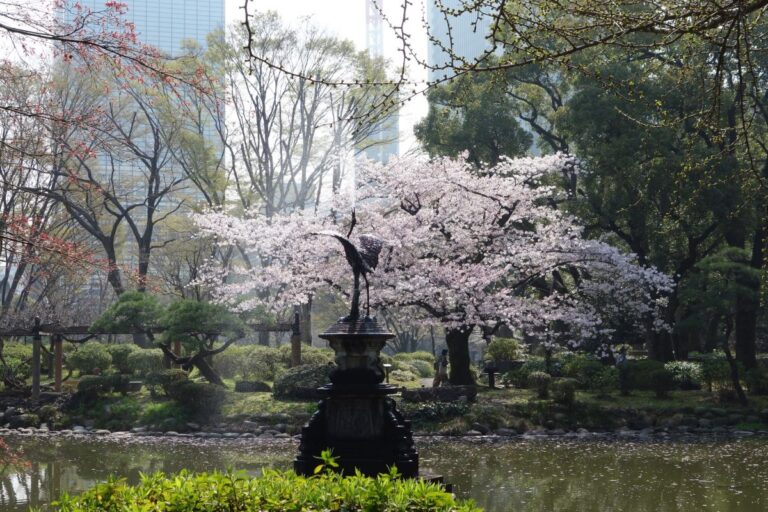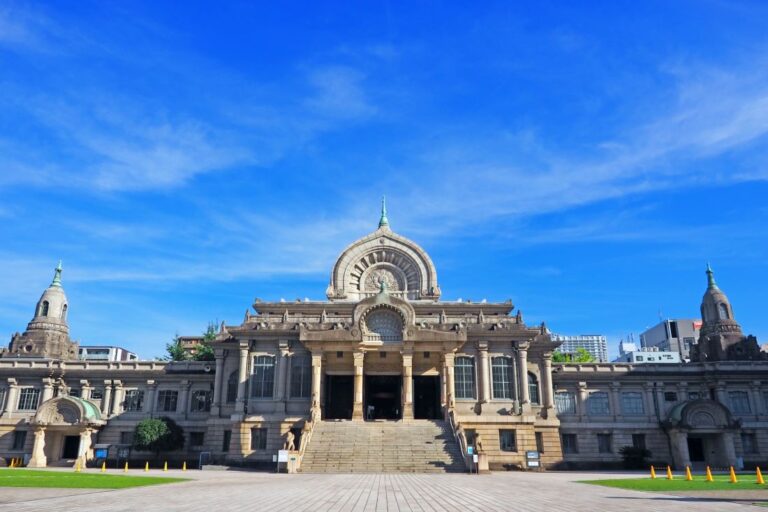Hie Shrine, also known as Hie-jinja, is a Shinto shrine in Nagata-cho, Chiyoda-ku, in the center of Tokyo and sits just west of the National Diet Building. The shrine was originally founded in 1478 and has since been rebuilt times. It is dedicated to the deity of Mount Hiei, which is in Kyoto.

The shrine is known for its beautiful architecture and Torii gate and is also famous for its bi-annual Sanno Matsuri festival, which is one of Tokyo’s three major festivals and attracts thousands of visitors every year.
Visitors to the Shrine can enjoy exploring the grounds, which include buildings and a large torii gate. The shrine is also home to several interesting artifacts and offers stunning views of the surrounding city.
History

Hie Shrine, also known as Hiyoshi Taisha, is one of the oldest and most revered Shinto shrines in Tokyo. It was established in 1478 during the Muromachi period, and was originally in the Hie area of Chiyoda ward. However, it was moved to its current location in Akasaka in 1659 during the Edo period.
The shrine was built to enshrine three kami (Shinto deities) – Oyamakui-no-kami, Hime-gami, and Take-minakata-no-kami – who are believed to protect the city from disasters, especially fires. As a result, the shrine has been a popular destination for locals to pray for safety and protection for centuries.
During the Meiji period, the shrine was designated as a Kanpei-taisha, which is the highest rank for a shrine in Japan. It was also visited by Emperor Meiji himself, who prayed for peace and prosperity for the country.
Today, the shrine continues to play an important role in the lives of Tokyoites and is especially popular during the New Year’s holiday when thousands of people visit to offer their first prayers of the year.
Architecture

The shrine’s main hall, or honden, was built in the Nagare-zukuri style, which is characterized by its sloping roof and curved eaves. The honden is made of hinoki cypress wood and has a thatched roof. The thatched roof is not only aesthetically pleasing but also practical, as it helps to regulate the temperature inside the building.
Another notable feature of Hie Shrine’s architecture is its torii gate. The torii gate is the entrance to the shrine and is made of stone. The gate is painted bright vermilion, which is a common color for torii gates in Japan. The torii gate at Hie Shrine is particularly impressive because it is one of the largest in Tokyo.
The shrine also has a beautiful chrysanthemum garden, which is behind the main hall. The garden is home to over 200 varieties of chrysanthemums and is open to the public during the autumn months. The garden is a peaceful oasis in the heart of Tokyo and is a great option for anyone interested in Japanese flora.
Festivals and Events
Hie Shrine hosts festivals and events throughout the year, attracting both locals and tourists. Here’s a few of the most popular ones:
Sanno Matsuri

The Sanno Matsuri Festival is one of Tokyo’s three major festivals, held every two years in mid-June. The festival is dedicated to the deity of Hie Shrine and features a procession of portable shrines, floats, and performers. The highlight of the festival is the parade of the mikoshi (portable shrines) through the streets of Tokyo, accompanied by traditional music and dance.
Hie Shrine Autumn Festival
The Hie Shrine Autumn Festival, also known as Hiwatari Matsuri, is held annually on the third Sunday of October. The festival is famous for its fire-walking ceremony, where participants walk barefoot over hot coals to purify their souls and pray for good health and fortune. The festival also features a parade of portable shrines, traditional music and dance performances, and food stalls.
New Year’s Eve Bell Ringing
On New Year’s Eve, Hie Shrine hosts a bell-ringing ceremony to welcome the New Year. You can participate in the bell-ringing and make a wish for the coming year. The ceremony starts at midnight and attracts a large crowd of locals and tourists.
Other Events
In addition to these major festivals, Hie Shrine also hosts smaller events throughout the year, such as the Setsubun Festival in February and the Chrysanthemum Festival in November. You can check the shrine’s website for the latest information on upcoming events.
The shrine is especially popular among girls because Rika-chan is a shrine maiden during the Shichi-Go-San (Seven-Five-Three-Three Festival).
Visiting Hie Shrine

Firstly, Note that the shrine is open daily from 6am to 6pm, and admission is free. Visitors are encouraged to dress modestly and remove their shoes before entering the main shrine area. It’s also customary to bow and clap twice before praying at the shrine.
One of the main attractions at Hie Shrine is the beautiful torii gate that marks the entrance to the shrine grounds. You can take a leisurely stroll through the grounds, admiring the lush greenery and traditional architecture. There are also smaller shrines and statues throughout the grounds that are worth exploring.
For those interested in learning more about the history and significance of Hie Shrine, guided tours are available in English and Japanese. The tours are led by knowledgeable volunteers who are happy to answer any questions visitors may have.
Finally, no visit to Hie Shrine would be complete without trying some of the local street food. There are food stalls near the shrine entrance that offer traditional Japanese snacks and drinks. Be sure to try the delicious taiyaki (fish-shaped cakes filled with sweet red bean paste) or a refreshing glass of matcha (green tea).
New Year’s Visit (Hatsumode)
The shrine enshrines Ohoyamakuhi no Kami, the deity of Oyama Kakui. The shrine’s divine virtues include the growth and development of all things, protection of industry in general, protection from bad luck, safe delivery, matchmaking, prosperous business, prosperity of the company, and fulfillment of wishes.
During the Hatsumode (New Year’s visit), a Shinto performance is dedicated at the Wakamizu Festival and the New Year’s Day Festival is held, attracting many worshippers.
Visitors to the shrine are offered a free-flowing sake. From the nearest station, Tameike-Sanno Subway Station is about a 3-minute walk away. From the Kokkai-gijidomae subway station, it is a 5-minute walk.
There are about 100 parking spaces available, but it gets very crowded during Hatsumode (New Year’s holidays), and since it is close to the station, we recommend using public transportation.

| Name | Hie Shrine 日枝神社 |
|---|---|
| Address | 2-10-5 Nagatacho, Chiyoda-ku, Tokyo |
| Access (by train) |
|
| Access (by car) | |
Where To Stay In Tokyo
Tokyo visitor levels are currently at an all-time high so make sure to book your hotels early. Tip most hotels booked with booking.com have free cancelation so book as soon as you know your date and you can always cancel if you change your mind.






